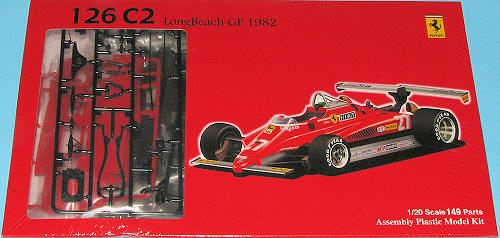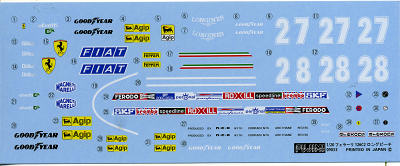
Fujimi 1/20 Ferrari 126 C2 (Long Beach)
| KIT: | Fujimi 1/20 Ferrari 126 C2 (Long Beach) |
| KIT #: | 090337 |
| PRICE: | $ |
| DECALS: | Two options |
| REVIEWER: | Scott Van Aken |
| NOTES: | New mold kit |

| HISTORY |
The Ferrari 126C was designed to replace the highly successful but obsolete 312T series in use since 1975. The basic chassis was almost identical to the previous car but the smaller V6 turbo engine suited the ground effect aerodynamics now needed to be competitive, and was a better package overall. The engine was fitted with twin KKK turbochargers and produced around 600bhp in qualifying trim, detuned to 550bhp for the races proper. The car proved to be very fast but Gilles Villeneuve found the handling to be atrocious. The engine had massive turbo lag, followed by a ferocious power curve; this upset the balance of the chassis. Coupled to the chassis' hard suspension, the car tended to slide into corners before the ground effect pulled the car back on to the track. This had the undesired effects of exposing the drivers to even larger g-forces than the Williams FW07 or Brabham BT49 and making the car tend to overuse its tyres. In all it made for a very tricky driving experience.
The car was first tested during the Italian Grand Prix in 1980. In testing it proved far faster than the 312T5 chassis the team were then using and Gilles Villeneuve preferred it, though he had reservations about the handling. Early unreliability of the turbo engine put paid to Villeneuve's 1981 championship hopes but he did score back to back victories in Monaco and Spain, as well as several podium places. Because of the problematic handling the 126C was at its best on fast tracks such as Hockenheim, Silverstone, Monza and the Ísterreichring.
With the arrival of Harvey Poslethwaite and a complete overhaul of the car in time for the 1982 season, things looked better. The turbo engine was further developed and reliability found, while the chassis was completely redesigned, featuring Ferrari's first genuine full monocoque chassis. Smaller and nimbler, the 126C2 (the subject of this kit) handled far better than its predecessor. Villeneuve and Didier Pironi posted record times in testing with the new car and began the season promisingly with several solid results. Then came the infamous race at San Marino where Pironi disobeyed team orders and stole the win from Villeneuve. The fallout from the race led to Villeneuve's tragic death in an horrific accident during qualifying at the next round in Belgium, which left Pironi as team leader. Pironi himself was nearly killed in a similar accident in Germany, putting an end to his motor racing career, but this didn't stop Ferrari from winning the constructors' championship that year. The 126C2 was further developed during the season, with new wings and bodywork tried, and the engine's power boosted to 650bhp in qualifying trim and around 600bhp in races.
Mandatory flat bottoms for the cars were introduced for 1983, reducing ground effect, and the 126C3 was designed with this in mind. Poslethwaite designed an over-sized but effective rear wing which clawed back around 50% of the lost downforce, whilst further compensation came from the engineers who boosted the power of the engine even further, to around 700bhp. Patrick Tambay and RenÚ Arnoux scored four wins between them and were both in contention for the world championship throughout 1983 but late unreliability cost them both. However, Ferrari took the constructors' title for the second year in a row.
The 1984 season season wasn't as successful, as McLaren introduced their extremely successful MP4/2 car, which was far more effective than the 126C4 and dominated the year. Michele Alboreto won just once and Ferrari finished as runner up in the constructors' championship.
The 126C series cars won 10 races, took 10 pole positions and scored 260.5 points.
| THE KIT |
 Fujimi
has built up an excellent and well deserved reputation for producing well molded
and detailed car kits. This one is no exception. It seems that 1/20 scale is
used almost exclusively to do Formula 1 car kits. This is undoubtedly due to the
somewhat small size of the actual car and so providing kits in this larger scale
gives a model of reasonable size.
Fujimi
has built up an excellent and well deserved reputation for producing well molded
and detailed car kits. This one is no exception. It seems that 1/20 scale is
used almost exclusively to do Formula 1 car kits. This is undoubtedly due to the
somewhat small size of the actual car and so providing kits in this larger scale
gives a model of reasonable size.
Molded in red, black and clear. The nearly 150 parts are on a dozen sprues, two of which are plated chrome and aluminum. The molding is superb with nary a sign of flash or sink areas. There are some ejector pin marks to be sure, but most will be hidden after construction or easily removed.
The driver's compartment is superbly done, missing only a racing
harness to be complete. The engine is a jewel and consumes about a third of the
construction steps in the instruction sheet. Rubber tires
 are
included and they are hollow so will provide the needed 'give'. Fujimi has gone
to great lengths to provide a most detailed suspension system. It looks properly
light and 'spidery', though like a rigged biplane, should prove to be quite
sturdy when all the parts are assembled. Only the main body bits are molded in
red, undoubtedly to assist in painting!
are
included and they are hollow so will provide the needed 'give'. Fujimi has gone
to great lengths to provide a most detailed suspension system. It looks properly
light and 'spidery', though like a rigged biplane, should prove to be quite
sturdy when all the parts are assembled. Only the main body bits are molded in
red, undoubtedly to assist in painting!
Instructions are superbly done with well drawn construction sequences and detail drawings where needed. Color references are by Gunze paints and since the instructions are almost all in Japanese, figuring them out will be a touch difficult for some. Markings are provided for the two cars at Long Beach in 1982. One driven by Gilles Villeneuve and the other by Didier Pironi, two drivers whose driving careers ended in 1982 with Villeneuve being killed and Pironi very badly injured in crashes prior to races. Markings are very well done and give you all the needed stencils and striping.
| CONCLUSIONS |
Overall, an outstanding new kit that I'm sure will find favor with those who like racing cars. As it is a Ferrari, it is bound to sell well and quickly.
| REFERENCES |
http://en.wikipedia.org
April 2008
My thanks to www.dragonmodelusa.com
for the review kit. Get yours today at your local shop or ask them to order it
for you. If you would like your product reviewed fairly and quickly, please
contact
me or see other details in the
Note to
Contributors.